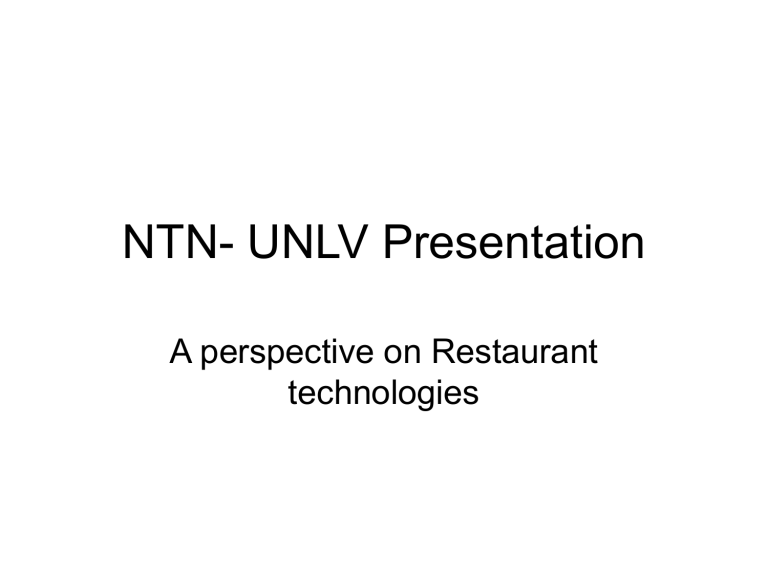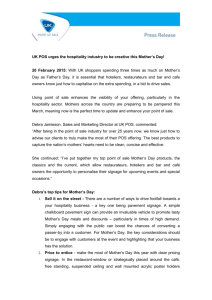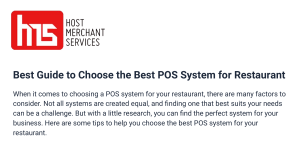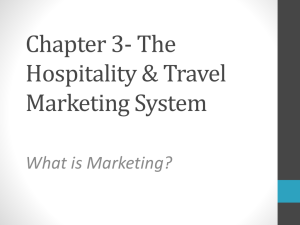Result: The reseller model evolved

NTN- UNLV Presentation
A perspective on Restaurant technologies
Agenda
• What constitutes technology in hospitality?
• Do technology and Hospitality mesh?
• Why has the hospitality industry been slow to adopt technology?
• How are the technologies distributed?
• What technologies are available?
• What barriers may still exist to any technology?
• What might you consider when selecting a technology?
• I may answer more than I have listed…
Why hospitality technologies?
• Creative industry – almost artistic
• Entrepreneurial - many passionate people
• Experimental – restaurant owners are always willing to try something new
• My job is safe - Restaurants will always need help with technology
Past
• Cash register mentality
– 5-10 years behind the “real” business world
• First technologies provided simple solutions (late
1980’s – early 1990’s)
• Hospitality technology got its biggest push when
Point-of-sale solutions (POS) were introduced
• The Barriers to adoptions were significant
Barriers to Adoption
• Technology was a burden, not an opportunity
• The restaurant was an art first, business second
• Restaurants viewed technologies as intrusive
– Technology detracted from, rather than enhanced the customer experience
– Technology was impersonal
• Restaurants feared the complexity of implementing and managing technologies
• Technology was ‘costly’
• There are obviously exceptions
– Marriott, McDonalds created POS companies
Examples
• Hand held terminals
• Liquor control systems
• Self order kiosks
• Reservations solutions
• Result
– If the technology impacted the customer experience, it was left behind
– Logical business decisions did not pass the
‘ambiance’ test
Distribution as a Barrier
• POS companies came first
– Cash and basic process control was first
• Solutions were proprietary (firmware)
– Expensive to purchase, implement, and maintain
– Development mentalities were insular
• A highly organic and fragmented market was difficult to approach
• Distribution was costly
– A market dominated by independents / small chains
• Result: The reseller model evolved
Business Problems Solved (POS)
• Cash and Cost control – theft and abuse
• Data collection, aggregation, processing, reporting, and connectivity to additional solutions
(Reporting)
• Automation and consistency - replaced manual processes
– Added systems where there were none
– Replaced manual transactions and processes
Types of Technologies
• Cash control
– POS, PMS
• Process control
– POS, PMS, Kitchen solutions, bar solutions
• Cost control
– Inventory, Labor control
• Services
– Internet solutions, reservations
• Revenue Generating
– Loyalty and frequency solutions
• Local and enterprise level for all solutions
Balancing Act
• Can technology enhance without being intrusive?
– If the technology provides a direct/indirect benefit to the client it has a chance
• Direct – Internet reservations
• Indirect – Technologies that improve work environment for employees
– The higher the ‘price’ that the customer pays for the service, the less likely the technology will succeed
• It cannot detract from the customer experience
• How ‘apparent’ is the technology?
Desired goal
• Technology should tell us the following
– What works and what does not
– Where money is made and lost
– Where the problems are and why
– Who our customers are and how to treat them
• Where do decision makers most need to invest their time, and why
• This is still a difficult goal to attain
Solutions Characteristics
• Basic evaluation criteria
– Scalability – single unit or enterprise
– Supportability – requirements and services
– Choice and flexibility – Migration path
– Function - Ability to meet current and future requirements
– Cost – short and long-term (cost of ownership)
– Impact – On the business and the customer
– Distribution – Direct or indirect, integrated or vertically integrated
The Future…
• Technology is already driving changes (Internet)
• Reduce costs or increase revenues?
– In general, restaurants adopted the first already
• Increase, decrease the footprint of technology?
– Generalization: The less expensive and quicker the food, experience is, the more welcome technology is
• Collect more data or interpret what you have?
• Catch up with the ‘real’ world, or stay an artist?
– Can you do both?
• Specific technologies to watch (ASP’s)
– What is the basic value proposition required?
Solutions Gaining Momentum
• ASP models
– Enterprise solutions
– Reservations and guest solutions
• Kitchen video
• CRM tools of any kind (as long as they are not intrusive) – few will succeed
• Basic Business Intelligence – Alerts and centralized reporting
– BI does not exist in this industry yet





